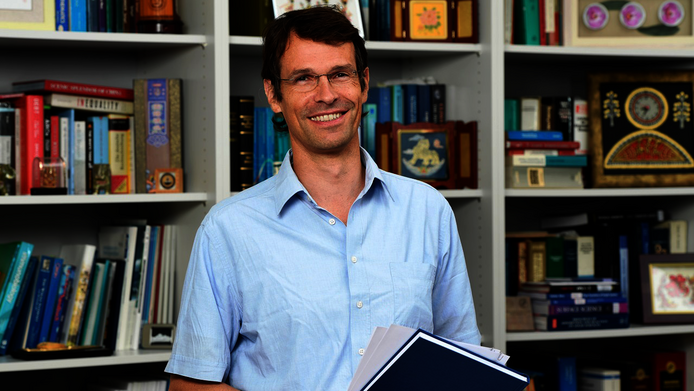“It’s hard to explain why this is taking so long”

FWF: For around 20 years, research and funding institutions have been working to bring academic publishing into the digital age and to enable free access to knowledge. A large number of initiatives have resulted in considerable progress. Plan S is the latest attempt in that direction – what do you think of it? Ulrich Pöschl: Open access to research findings via the Internet has been developing in science since the early 1990s. Originating directly from active researchers, the motivation and underlying principles were developed and initiated in a “bottom-up” process. In the early 2000s, science institutions also adopted these principles. The Berlin Declaration on Open Access of 2003, for example, was signed by more than 600 leading research organisations worldwide. Many of them are also working together in the global OA2020 initiative to achieve a timely transition to Open Access in line with academic interests. As a result, the proportion of freely accessible and freely usable scholarly journal articles has risen to around 15 percent in recent years. On the other hand, a large part of publicly funded research results still remain under lock and key subject to the subscription and payment barriers of traditional academic publishers and cannot be used efficiently in research and teaching either by the general public or the business community. For this reason, Plan S has been developed as a top-down initiative by public and non-profit research funders who also call for Open Access. This approach is an important supplement to the existing bottom-up initiatives from the research community and will accelerate the transition to a modern academic publishing system, something that is long overdue. All these efforts are intended to facilitate and improve the exchange of knowledge and the provision of education. This holds true both for the research community and for human society worldwide. In times of alternative facts and post-factual claims, these values are more important than ever. One of many important aspects is to bring scientific insights and general knowledge closer together again. In this context one may explain the benefits of Open Access using the example of the online encyclopaedia Wikipedia, which even researchers frequently use for quick reference. Nonetheless, there are usually very few illustrations of scholarly content on Wikipedia and other websites because the copyright of the corresponding original illustrations has been transferred to the publishers, and not even the researchers themselves are free to use them. As a result, scientific content on the Internet is often presented in a far less appropriate and comprehensible manner than should be both possible and desirable.
FWF: What does the implementation of Plan S mean for researchers? Pöschl: An Open Access publication is worth a great deal more than an article under lock and key – both for the public and for the research community. Researchers benefit from a faster and wider dissemination of their results, from knowledge being exchanged freely between different disciplines, and from authors who retain the copyright on the published text and illustrations. This may seem to be a minor detail to outsiders, but it is of enormous importance. There is good reason for its being enshrined in Plan S as the number-one principle. Plan S breaks up oligopolistic structures and also gets large academic publishers to allow Open Access publications in established journals in a scientifically and financially appropriate way. In the past this often did not materialise owing to the publishers’ dominant position and excessive striving for profit. The scheme is designed to result in no effort, or as little effort as possible, for the researchers themselves – in terms of time and/or money. Plans S, OA2020 and related initiatives aim at ensuring the most efficient and smooth transition possible from the subscription systems of the past, which are obsolete in many respects, to an Open Access publishing system fit for the future. FWF: One objective of COAlition S – the supporters of Plan S – is to provide free access to all scholarly publications under public domain licenses – without the usual embargoes set by the publishers. At present, some publishers are not yet ready to publish open access in important science journals. Could this constitute a problem for some disciplines? Pöschl: It has been demonstrated for many years that Open Access is compatible with operating high-quality journals successfully and sustainably. This is true of both the so-called STM subjects – science, technology and medicine – and of the humanities and social sciences. There are many successful examples to show that both options are readily achievable: launching new high-quality OA journals and converting traditional subscription-based journals to OA. Some glossy journals also offer various options, such as archiving a version of the manuscript in a freely accessible repository. Moreover, there are many voices in the scientific community who believe that the importance of glossy journals is overrated. Among other things, Open Access also facilitates a better evaluation of individual publications through so-called “article level metrics” and reduces the tendency to overrate certain journals and indicators such as “journal impact factors”.
The profit margins of the large publishers and the public expenditure on journal subscriptions are so large that there is more than enough funding available for a sustainable transition to OA. Experience shows that small publishers can also transition successfully to OA, and it offers them additional opportunities in a competition which has been strongly distorted in favour of the large publishers and hampered by oligopolistic structures. The development of Plan S involved representatives from a wide range of disciplines. If practical application should reveal that, contrary to expectations, the flexibility and diversity of publishing and archiving options already provided for in Plan S were not sufficient for certain fields and disciplines, the scheme could and would certainly undergo further adjustments and differentiations. As a representative of a bottom-up initiative such as OA2020, I consider it particularly important that the practical implementation of Open Access takes into account the needs of different research fields and communities. As far as I can tell, the representatives of Plan S, a top-down initiative, share this view and have achieved a good result. FWF: There are also critical voices from the research community who consider the Open Access plan to be too fast or too far-reaching. You are a chemist. Can you understand this scepticism from a scientist’s perspective? Pöschl: I can actually understand it and would probably be a sceptic myself if I had not explored the matter in great detail. Most of the concerns arise from a lack of information or from the lobbying and oligopolistic position of traditional publishers. One problem in the past was that individual researchers were confronted with the question of whether and where they could publish their articles in Open Access mode. And the question was, in particular, whether or not publications in established scientific journals are compatible with Open Access, and what the costs and consequences of Open Access publication might be. Plan S is now designed to eliminate these concerns and uncertainties by making Open Access the default option, by changing the financing of publishing and by demanding corresponding services from publishers.
This should not result in additional expense, let alone disadvantages, for the researchers. Funding agencies such as the FWF, research institutions such as the Max Planck Society, and national consortia in Germany and other countries have already concluded so-called transformative agreements or “publish & read” agreements with large and small publishers, which enable authors working in these fields to publish open access articles in traditional journals without additional effort. Publishers can offer these or similar agreements to all academic institutions and other subscribers without too much effort. This makes it possible to fulfil the bulk of the goals and objectives of OA2020 and Plan S, and to translate Open Access into a global reality.
Irrespective of such agreements, the minimum requirement must be that authors of journal articles be allowed and able to archive the final version of their articles in freely accessible repositories without embargo periods. Usually, this is already the case. Wherever this is not yet possible, science publishers have to adapt to it, because the papers they publish in journals are mainly based on publicly funded research. Also, the income of publishers and their sometimes exorbitant profit margins of up to 40 percent are also funded predominantly out of public money. For this reason, it is not only appropriate and feasible, but it is long overdue for the general public to be able to freely access and use results and publications of publicly funded research. FWF: In spring 2020, the Springer Nature publishing house, which counts 3000 journals in its portfolio, announced that the renowned journal Nature would be converted to Open Access in line with Plan S as of 2021. It seems that the publishing giants are now starting to come on board.
Pöschl: That is exactly the point. What is at stake is breaking up outdated and petrified structures or overcoming structural barriers. This requires catalysts such as OA2020 and Plan S. By coordinating the highly diversified world of non-profit research funders, universities, research institutions, public libraries and other academic institutions, it is possible to stand up to the large international publishing houses, which are often driven by the desire to maximise profit and preserve market clout. When asked to implement Open Access, various publishers raised almost absurd claims, demands and objections, and skilfully asserted their business interests along the lines of “divide and rule”. Thanks to national and international scientific initiatives and collaborations, people are now starting to realise again that it is the publishers who should provide a service for research and not the other way round. In addition to Springer Nature, Wiley and other large and smaller publishers have also read the signs of the times and are increasingly participating actively in the global transition to Open Access. On the other hand, Elsevier, the largest and most profitable publisher of scientific journals, has hardly moved at all so far, which only serves as confirmation that introducing Plan S makes sense and is necessary. FWF: Analyses have shown that universities and research institutions would save costs by switching their publishing systems to open access and that publishers could still remain profitable. How can a modern system work for all the stakeholders? Pöschl: Comprehensive analyses of the global publication market illustrate that expenditure for access to journals averages around 4000 euros per article in the traditional subscription business dominated by large publishers. In OA journals of comparable quality, realistic prices per article are at around 2000 euros or less. In my own field of research, the atmospheric sciences and geosciences, some of the world’s leading and largest journals of the highest quality and visibility have been pure Open Access journals for two decades. They are owned by the European Geosciences Union, which holds regular conferences in Vienna with up to 16,000 participants, and are produced by a medium-sized German publishing house. The income and profit for both the publisher and the society are respectable. Moreover, efficient use of modern technologies keeps the average price per article there at only around 1500 euros. This example shows that Open Access is not so much a threat as a great opportunity for small publishers in Europe. Based on the above analyses and empirical data, we can assume that the financial buffer and scope for the transition to Open Access, and for an academically appropriate design of the journal publishing system, is something like 50 percent of current expenditure and available public funds in real terms. Consequently, the alleged threat to the academic publishing system and its fundability through open access simply does not exist.
Even if average costs were not to fall as a result of the transition to Open Access, the cost-benefit ratio of publishing as a whole will improve significantly, since the practical value of academic publications for science and society will increase several fold through free access and usability. Moreover, making the system more practically useful for the general public is considerably more important than any cost reduction, since the publication costs as a whole make up only about one percent of public expenditure on research. It is actually hard to explain why this transition is taking so long and did not occur some 20 years ago, when the Internet became widely available and most of the world’s leading academic organisations committed themselves to Open Access. Just one more reason why the introduction and implementation of Plan S is long overdue. FWF: The Max Planck Society actively supports Open Access initiatives in Germany. What are the key findings obtained so far? Pöschl: In the Max Planck Society, Open Access has been promoted by the scientific members and endorsed by the management for many years. Not only do we call on traditional large publishers to use Open Access, we also support small and new Open Access publishers. As a result, and as a consequence of transformative agreements concluded at both institutional and national level, the Open Access share of our journal publications has already reached around 80 percent, which means that we have already largely met the objectives of OA2020 within our institution. Regrettably, this is not yet the case worldwide, but it shows that each individual institution by itself can make a big difference and thus also foster global progress. Fortunately, other organisations are also successfully pursuing this path, including the University of California as one of the largest academic institutions in the world, but also including the FWF, the University of Vienna and other Austrian institutions. FWF: Would it be easier with uniform standards? The wish for and the benefits of a common approach, and uniform – or at least compatible – standards, are among the main reasons why many countries and institutions in Europe and throughout the world have already joined Plan S, OA2020 and related initiatives. The greater the unity, the easier it is for the interests of science to prevail over the oligopoly of the international big players in the publishing world. FWF: What does this mean for society and science communication? Pöschl: Around one percent of the total expenditure and public spending that society invests in science goes into publishing. When you take a good look at this ratio, you understand that various lobbyists have been successful too often and for too long in doing what the English language so idiomatically refers to as “the tail wagging the dog”. It is absurd that about 99 percent of the total public expenditure and the associated benefits are locked away behind the pay walls of commercial publishers for about one percent of the costs, even though the Internet makes it possible to offer free access without significant additional costs. Making the results of scientific research and its illustrations in publications freely accessible and usable will benefit all areas of our social life. This applies to research itself, particularly in its interdisciplinary work and global networking; to education at schools, universities and in adult education; to the media and their handling of fake news, alternative facts and post-factual claims; and to business and technological innovations. It is very difficult for smaller companies to use original scientific publications, regardless of whether these are up-to-the-minute or decades old. Even large companies that have the resources to buy access to scientific journals can encounter massive constraints in using content efficiently via data mining or machine learning because of technical access restrictions created by the security measures and pay walls of publishers. All these areas offer huge potential that can be unlocked through Open Access. The corona pandemic has shown how important scientific exchange is – including for the media and the general public. I am confident that this experience will help raise awareness that free access to knowledge is a value in itself. This is true not only, but also, of crisis situations.
Ulrich Pöschl has been a champion of Open Access as a researcher and university lecturer since 2000. A chemist by training, he conducts research in the field of atmospheric, climate and health sciences. He is a scientific member of the Max Planck Society, Director at the Max Planck Institute for Chemistry, and Professor at the Johannes Gutenberg University in Mainz. Pöschl is also the founder and editor of Atmospheric Chemistry and Physics (ACP), the world’s first scientific Open Access journal with public peer review, and the initiator of the international Open Access initiative OA2020. Supported by a Schrödinger Fellowship from the Austrian Science Fund FWF, Pöschl did postdoctoral research at the Massachusetts Institute of Technology in Cambridge, Mass. (USA), from 1996 to 1997.
A revolutionary Plan S
Plan S operates with the objective of making the results of publicly funded research freely accessible from 2021 forward. In addition to the Austrian Science Fund FWF, 16 other national – mainly European – funding agencies have joined the initiative, as have seven of the world’s largest private sponsors and organisations, including the World Health Organisation, the Bill & Melinda Gates Foundation and the Wellcome Trust. Among the Initiative’s supporters one also finds the European Commission, which intends to base its Open Access policy on Plan S. In the context of FWF-funded research, Plan S applies to all research projects approved as from 1 January 2021. Academic articles with peer review resulting from these projects must be made openly accessible without delay. This will apply to the first FWF-funded projects from around the end of 2021 or early 2022. For publication formats such as monographs and anthologies, binding guidelines will be drawn up by the end of 2021.
More information New Open Access Guidelines Starting in 2021 https://www.coalition-s.org/






